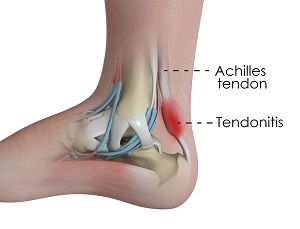
What is Achilles Tendinitis?
Achilles tendinitis is the inflammation and irritation to the Achilles tendon, a strong fibrous cord present behind the ankle that connects your calf muscles to the heel bone. Certain activities can cause an overuse injury to the Achilles tendon, particularly in middle-aged people participating in sports activities occasionally.
Risk Factors
The common risk factors that may cause Achilles tendinitis include:
- Sports and Exercise
- Insufficient warming up before exercise
- Poorly-fitting footwear while running
- Running on uneven surfaces or uphill
- Quickly changing your speed
- Sports such as football, baseball, volleyball and tennis
- Medical Conditions
- Stiff muscles
- Bone spurs
- Psoriasis
- High blood pressure
- Certain medication
- Glucocorticoids
- Fluoroquinolones
Symptoms
You may hear a snapping or popping sound during the injury. The common symptoms of Achilles tendinitis include:
- Morning pain and stiffness along the Achilles tendon
- Severe pain while running, climbing and exercising
- Thickening of the tendon
- Inflammation at the back of your heel
- Inability to rise on your toes
Diagnosis
Your doctor will take a medical history and perform a physical examination. Imaging tests such as X-ray, MRI or CT-scan will confirm the diagnosis.
Treatment
Your treatment plan may include the following:
- Rest: Rest your foot by refraining from the activities that may cause further injury.
- Ice packs: Use of ice packs may be suggested to reduce inflammation.
- Compression: Wrapping with an elastic bandage or compression stocking can help minimize swelling and support your foot.
- Elevation: Elevating your leg above heart level will also help reduce swelling and pain.
- Pain medications: A combination of non-steroidal anti-inflammatory drugs (NSAIDs) and opioids may be used to manage pain.
- Exercise: Physical therapy exercises will be taught to enhance your flexibility, range of motion and strength.
- Shoe modifications: Your doctor may suggest a shoe with heel lifts to prevent further injury.
- Injection therapy: This involves administering steroids through a needle at the back of your heel to relieve pain and inflammation.
Surgery may be recommended by your doctor if you do not respond to non-surgical treatment options. Depending on the severity, any one of the following surgeries will be performed:
- Gastrocnemius Recession: This procedure involves surgical lengthening of your calf muscles to improve flexibility and motion of the ankle.
- Debridement and Repair: The damaged part of the Achilles tendon is surgically removed and a tendon transfer may be performed. Debridement of bone spurs may be performed followed by placement of plastic or metal anchors to hold the tendon until your bone heals.
Prevention
Achilles Tendinitis can be prevented by avoiding the risk factors that may cause overstretching or an injury.



